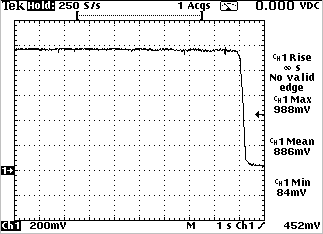
Oxygen Sensor Verification
To verify the Oxygen sensor, make sure the sensor is at
operating temp,
(run above 2000
rpm for two minutes with engine at operating temp, for
heated sensor's, make sure the
element is good and getting power and
ground) increase engine rpm to 2500 rpm for two minutes, then
return
to idle, let stabilize. Force the
engine rich with propane and look for
maximum voltage reading (should rise above 800mv).
After it flat-lines
rich, quickly shut off propane and it should reach its minimum
voltage
reading (should go below at least 150mv). The waveform below
gives
you an example of what
you should see. When the propane is shut off,
the sensor signal should drop from its full
rich to full lean limit.

Before the computer gets a chance to take over again, snap
the throttle
wide open while
its still full lean and release to idle position, and see
how fast it rises to its full
rich reading. If it gets there in less than 100ms,
the sensor is adequate. If you want
precise control look for faster than that.
The image below illustrates how the signal will
look. If it can't get to less
than 150mv, or more than 800mv, or if the lean too rich
speed is more than
100ms, the sensor is due for replacement.

I suppose there's a fine line here, if the numbers are close,
and its switching
good, I
suppose you could still call it adequate and fuel control
would also
be adequate. But if
you are dealing with emissions testing, you will need to
get the fuel control as tight as
possible. If the sensor can't tell the computer
the exact quantity of what is flowing past
it, or takes forever doing it, the
computer can't control fuel fast enough to permit the
Catalytic converter
to reduce emissions efficiently. (can cause efficiency codes)
Go to this page to see the test in action.
This test can be performed on the sensor installed at the
outlet of the
Catalytic
converter to verify its condition as well. These are looking
at
Oxygen levels on the
outlet side of the Cat, and should remain flat-lined
if the Cat is working efficiently.
You could look at both sensors
simultaneously while doing the propane test, get them both
flat lined
rich and record the max reading, then turn off the propane and
see if
they both respond, if they do, go ahead with the wide open
stab of the
throttle and look at the waveform, The front one should appear
as
above, the rear one should appear as below, you can see the
min,
max, and rise time.

When you start verifying Oxygen sensors, you will save a lot
of time
not replacing them
in hopes of correcting some drive-ability problem
you can't seem to nail down. Once you
know the sensor is good, you
can forget about it being the cause of the problem you are
trying to correct.